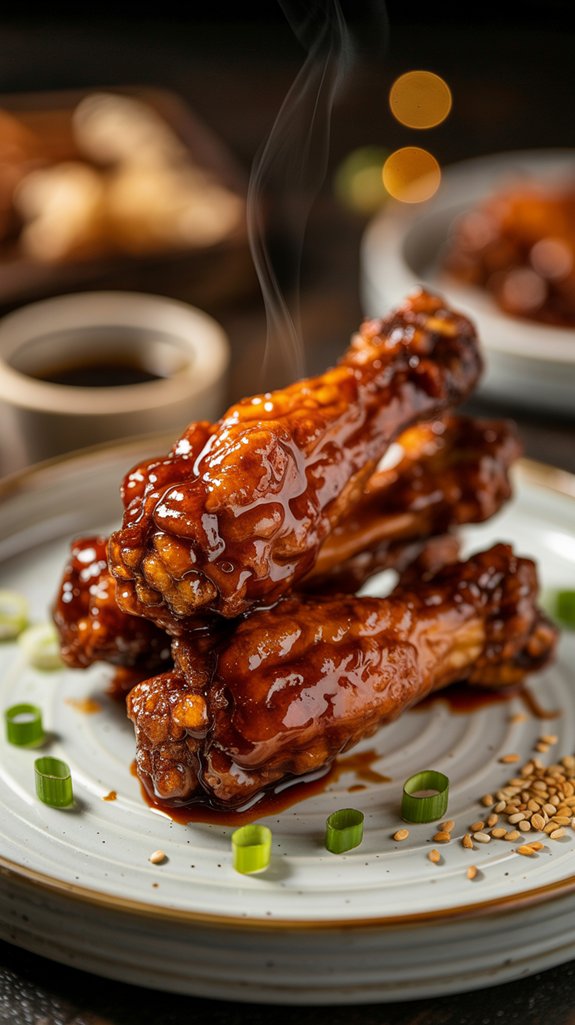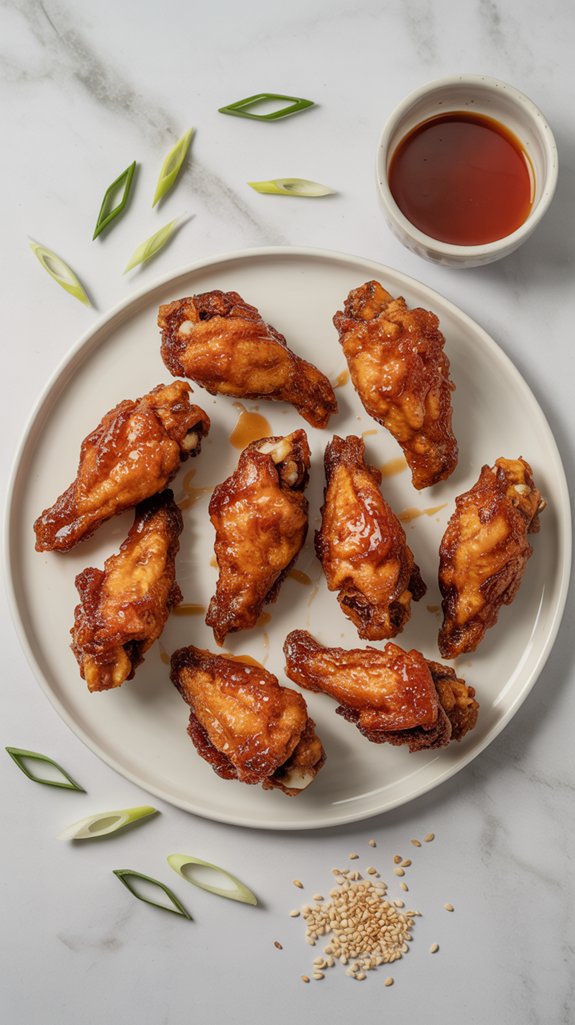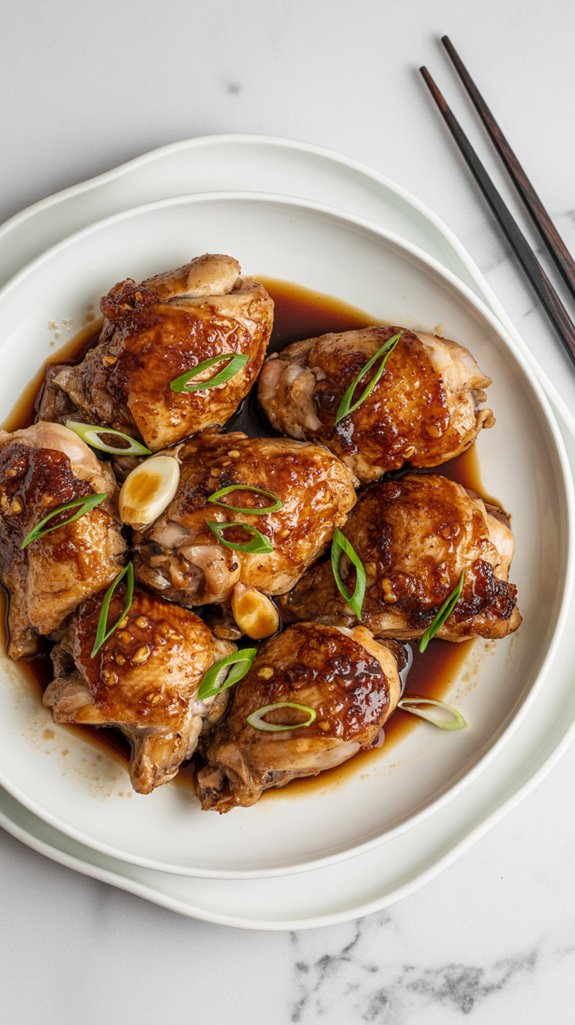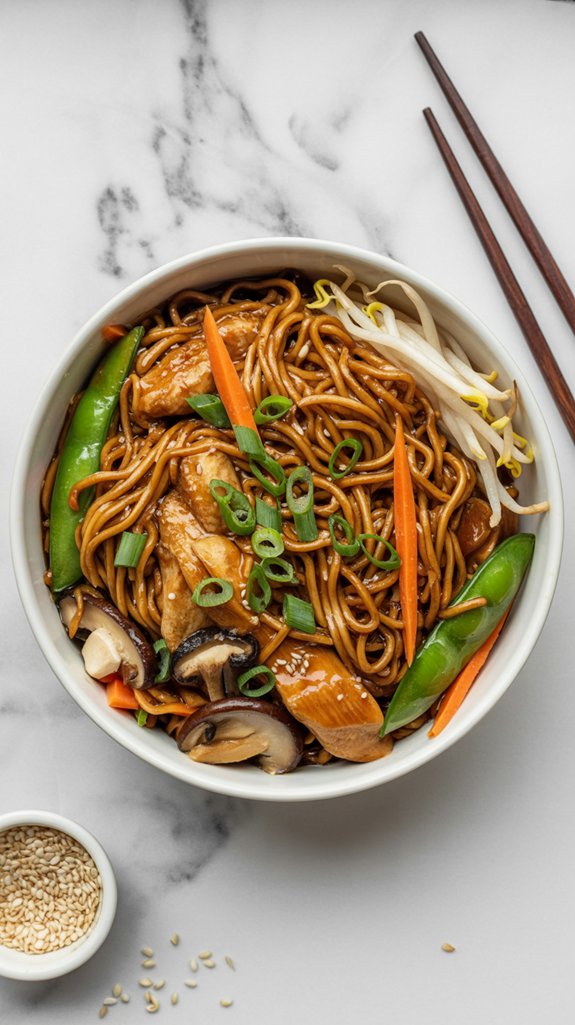Why You’ll Love This these Crispy Double-Fried Korean Chicken Wings
These wings get their incredible crunch from a thick, pasty coating that clings to every curve and crevice, creating that signature Korean fried chicken texture that’s somehow both shatteringly crisp and surprisingly tender.
The secret lies in that unusual batter made with potato starch and flour, plus a whole bunch of garlic that transforms ordinary chicken wings into something that’ll have you questioning why you ever settled for regular buffalo wings.
Sure, the marinating takes a few hours and the batter looks a bit weird at first, but trust me on this one – that golden, crackling exterior is worth every minute of waiting.
Ingredients List
You’ll need just a handful of ingredients to create these addictively crispy wings, though fair warning – that grocery list might look a little intense at first glance.
- 1 (10 lb) bag chicken wings
- 1 onion
- 4 1/2 tablespoons salt
- 3 tablespoons ground pepper
- 1 1/2 cups flour
- 1 1/2 cups potato starch
- 1 cup sugar
- 1/4-1/3 cup minced garlic clove
- 1 teaspoon ginger powder or 1 1/2 teaspoons ginger puree
- 1 egg yolk only
A few things to keep in mind about these ingredients:
- That full cup of sugar might seem shocking, but it balances out the salt and creates that perfect sweet-savory Korean flavor profile.
- The potato starch is what gives these wings their signature crunch, so don’t try to substitute it with regular cornstarch.
- Ten pounds of wings feeds a crowd, so feel free to halve everything if you’re cooking for fewer people.
- All that garlic and ginger actually pack some anti-inflammatory benefits, which almost makes up for the deep frying part.
- The high sodium content means these are definitely a special occasion treat, not an everyday meal.
Step by Step Directions

These Korean chicken wings require careful preparation and marinating time, but the results are worth the wait.
Chicken Preparation:
- Cut fat off chicken wings and wash thoroughly.
- Place clean chicken in colander and drain all excess water completely.
Make the Paste:
- Finely dice half of the large onion into tiny pieces.
- Grind the remaining half of the onion (or grind the whole onion if preferred).
- Add ground onion to large mixing bowl.
- Add salt, pepper, flour, potato starch, sugar, minced garlic, ginger powder, and egg yolk to the bowl.
- Mix everything until it becomes a thick, pasty mixture.
- If mixture isn’t thick enough, add up to 1/2 cup potato starch and 1/2 cup flour.
- Taste the batter and adjust seasoning – add more salt and pepper if too sweet.
Combine and Cook:
- Add the dried chicken wings to the pasty mixture.
- Mix well to coat all pieces.
- Marinate chicken in refrigerator for at least 3 hours.
- Remove from fridge 1 hour before frying.
- Heat oil to 350°F in deep fryer.
- Fry wings for 8-12 minutes until golden and crispy.
- Cut through one wing to verify it’s fully cooked before serving.
For consistently perfect results, consider investing in a quality Korean chicken deep fryer specifically designed for achieving the crispy texture that makes this dish so popular.
Substitutions and Variations
Flour Swaps:
- Can’t find potato starch? Regular cornstarch works just fine, though you might lose a tiny bit of that signature crispiness.
- All-purpose flour can be swapped for rice flour if you want extra crunch, but use about 1/4 cup less since rice flour gets pretty dense.
- Tapioca starch is another solid substitute for potato starch, same measurements.
Sweetness Adjustments:
- Brown sugar instead of white sugar adds a deeper, almost molasses-like flavor that’s pretty amazing.
- Honey works too, but start with half the amount since it’s way sweeter, and you might need extra flour to balance the wetness.
- Maple syrup? Why not, but again, less liquid means you’ll be adding more dry ingredients.
Garlic and Ginger Tweaks:
- Fresh grated ginger beats powder every time, about 1 tablespoon of fresh for every teaspoon of powder.
- Garlic powder can pinch-hit for fresh garlic, roughly 1 teaspoon powder per clove, though fresh really is better.
- No ginger at all? The wings won’t be traditional, but they’ll still taste great.
Wing Alternatives:
- Drumettes work perfectly with this recipe, just bump up the cooking time by 2-3 minutes.
- Chicken thighs, cut into chunks, are incredible with this coating, though they need about 15 minutes in the fryer.
- Even boneless pieces work, but honestly, you’re missing out on all that crispy skin goodness.
Heat Level Options:
- Gochujang mixed into the paste adds authentic Korean heat, start with just 1 tablespoon.
- Regular chili flakes, cayenne, or sriracha all work if Korean ingredients aren’t handy.
Additional Things to Serve With This Dish
Korean fried chicken begs for sides that can handle its bold, sweet-savory personality.
Classic Korean Pairings:
- Pickled radish (danmuji) cuts through all that rich coating like a champ, plus the crunch factor is unreal.
- Kimchi brings fermented funk and spice that somehow makes the chicken taste even better.
- Steamed white rice soaks up any extra coating that falls off, because wasting that flavor would be criminal.
- Korean coleslaw with a sesame dressing adds vitality without competing for attention.
American-Style Companions:
- Regular coleslaw works great, especially the tangy vinegar-based kind that doesn’t get soggy.
- Corn on the cob with butter and a sprinkle of garlic powder keeps things simple.
- Mashed potatoes might sound weird, but trust me, that sweet-salty chicken gravy situation is magic.
- Biscuits for sopping up any sauce, because carbs and fried chicken are basically best friends.
Fresh and Light Options:
- Cucumber salad with rice vinegar dressing cools down your mouth between bites.
- Simple green salad with sesame oil and a touch of soy sauce stays in the Asian lane.
- Watermelon chunks, seriously, the sweetness plays so well with the savory coating.
- Edamame with coarse salt gives your hands something to do while you’re pacing yourself.
Drinks That Make Sense:
- Ice-cold beer, obviously, but Asian lagers like Hite or Sapporo feel right.
- Sweet tea balances the salt and spice perfectly.
- Sparkling water with lime keeps things invigorating without getting fancy.
Cooking Tips & Tricks (Chef’s Notes)
Making Korean fried chicken that actually tastes like the stuff from your favorite restaurant takes a few sneaky tricks that nobody talks about.
The Marination Game:
- Don’t rush that 3-hour minimum marinating time, because impatient chicken is sad chicken.
- Flip the wings halfway through marinating so every piece gets equal love.
- Room temperature chicken fries way more evenly than cold chicken, which is why we pull it out an hour early.
- If your paste looks too thick, add a tablespoon of water instead of panicking.
Temperature Control Secrets:
- Get yourself a thermometer because guessing oil temperature is how you end up with burnt outsides and raw insides.
- Drop the temperature to 325 if your wings are browning too fast, better to go slow than sorry.
- Don’t overcrowd the fryer, those wings need space to bubble and crisp properly.
- Let the oil come back up to temperature between batches, patience pays off here.
Coating Perfection:
- Pat those wings dry like your life depends on it, water is the enemy of crispy.
- The potato starch is doing the heavy lifting for crispiness, so don’t skip it for regular cornstarch.
- Mix that paste with your hands if you’re brave enough, it distributes way better than a spoon.
- Taste the raw paste before adding chicken, you can fix seasoning now but not after frying.
Pro Timing Moves:
- Double-fry method works great here, fry once at 325 for 6 minutes, rest for 2 minutes, then hit them again at 350 for 3-4 minutes.
- Drain on a wire rack, not paper towels, because soggy bottoms are the worst.
- Serve immediately while that coating is still crackling, Korean fried chicken waits for no one.
Nutritional Facts
Based on the recipe serving approximately 8-10 people, here’s the nutritional breakdown per serving:
- Calories: 485-520 per serving (3-4 wings)
- Protein: 28-32g from chicken wings
- Total Fat: 24-28g (mostly from chicken skin and frying oil)
- Saturated Fat: 7-9g
- Carbohydrates: 38-42g (from flour, potato starch, and sugar coating)
- Sugar: 12-15g from added sugar in the paste
- Sodium: 890-1,100mg (high due to salt in marinade)
- Cholesterol: 95-110mg from chicken and egg yolk
- Fiber: 1-2g minimal from onion and coating
- Calcium: 25-30mg
- Iron: 2-3mg from chicken
- Potassium: 220-280mg primarily from chicken
- Vitamin C: 3-5mg from onion and garlic
- Total Weight: Approximately 4-5 oz per serving
*Nutritional values are estimates and may vary based on oil absorption during frying, exact wing sizes, and preparation methods. Deep-fried foods are calorie-dense due to oil absorption during cooking.*
Fun “Did You Know?”
While most people think Korean fried chicken is a traditional dish, it actually didn’t become popular in Korea until the 1970s when cooking oil became more widely available.
I find it fascinating that this now-iconic food emerged during Korea’s rapid economic development. The double-frying technique that makes Korean fried chicken so incredibly crispy wasn’t borrowed from other cuisines—it’s genuinely Korean innovation.
What’s even more interesting is that Korean fried chicken restaurants often serve it with beer, creating the popular “chimaek” culture (chicken + maekju, meaning beer).
This pairing became so beloved that it’s now considered a Korean cultural phenomenon.





